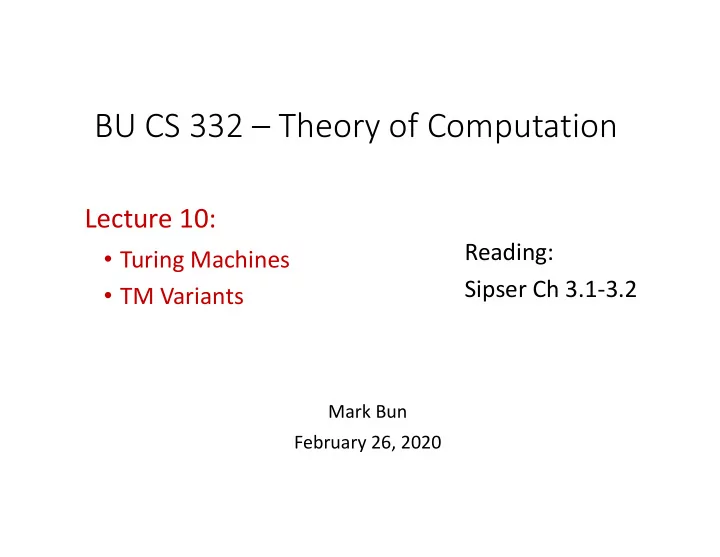

BU CS 332 – Theory of Computation Lecture 10: Reading: • Turing Machines Sipser Ch 3.1 ‐ 3.2 • TM Variants Mark Bun February 26, 2020
Turing Machines – Motivation So far in this class we’ve seen several limited models of computation Finite Automata / Regular Expressions • Can do simple pattern matching (e.g., substrings), check parity, addition • Can’t recognize palindromes Pushdown Automata / Context ‐ Free Grammars • Can count and compare, parse math expressions • Can’t recognize 𝑏 � 𝑐 � 𝑑 � 𝑜 � 0 � 2/26/2020 CS332 ‐ Theory of Computation 2
Turing Machines – Motivation Goal: Define a model of computation that is 1) General purpose. Captures all algorithms that can be implemented in any programming language. 2) Mathematically simple. We can hope to prove that things are not computable in this model. 2/26/2020 CS332 ‐ Theory of Computation 3
A Brief History 2/26/2020 CS332 ‐ Theory of Computation 4
1900 – Hilbert’s Tenth Problem Given a Diophantine equation with any number of unknown quantities and with rational integral numerical coefficients: To devise a process according to which it can be determined in a finite number of operations whether the equation is solvable in rational integers . David Hilbert 1862 ‐ 1943 2/26/2020 CS332 ‐ Theory of Computation 5
1928 – The Entscheidungsproblem The “Decision Problem” Is there an algorithm which takes as input a formula (in first ‐ order logic) and decides whether it’s logically valid? Wilhelm Ackermann 1896 ‐ 1962 David Hilbert 1862 ‐ 1943 2/26/2020 CS332 ‐ Theory of Computation 6
1936 – Solution to the Entscheidungsproblem "An unsolvable problem of elementary number theory“ Model of computation: 𝜇 ‐ calculus (CS 320) Alonzo Church 1903 ‐ 1995 “On computable numbers, with an application to the Entscheidungsproblem ” Model of computation: Turing Machine Alan Turing 1912 ‐ 1954 2/26/2020 CS332 ‐ Theory of Computation 7
Turing Machines 2/26/2020 CS332 ‐ Theory of Computation 8
The Basic Turing Machine (TM) Input 𝑏 𝑐 𝑏 𝑏 Tape … Finite control • Input is written on an infinitely long tape • Head can both read and write, and move in both directions • Computation halts when control reaches “accept” or “reject” state 2/26/2020 CS332 ‐ Theory of Computation 9
Example ⊔ → ⊔ , 𝑆 0 → 0, 𝑆 𝑟 0 𝑟 1 accept 0 → 0, 𝑆 ⊔ → ⊔ , 𝑆 reject
Example reject ⊔ → ⊔ , 𝑆 0 → 0, 𝑆 𝑟 1 𝑟 0 accept 0 → 0, 𝑆 ⊔ → ⊔ , 𝑆 0 → 0, 𝑆 𝑟 3 ⊔ → ⊔ , 𝑀
TMs vs. Finite / Pushdown Automata 2/26/2020 CS332 ‐ Theory of Computation 12
Three Levels of Abstraction High ‐ Level Description An algorithm (like CS 330) Implementation ‐ Level Description Describe (in English) the instructions for a TM • How to move the head • What to write on the tape Low ‐ Level Description State diagram or formal specification 2/26/2020 CS332 ‐ Theory of Computation 13
Example � � Decide if High ‐ Level Description Repeat the following: • If there is exactly one in , accept • If there is an odd number of s in , reject • Delete half of the s in 2/26/2020 CS332 ‐ Theory of Computation 14
Example � � Decide if Implementation ‐ Level Description 1. While moving the tape head left ‐ to ‐ right: Cross off every other 0 a) If there is exactly one 0 when we reach the right end of the b) tape, accept If there is an odd number of 0 s when we reach the right c) end of the tape, reject 2. Return the head to the left end of the tape 3. Go back to step 1 2/26/2020 CS332 ‐ Theory of Computation 15
Example � � Decide if Low ‐ Level Description 2/26/2020 CS332 ‐ Theory of Computation 16
Formal Definition of a TM A TM is a 7 ‐ tuple � ������ ������ • is a finite set of states • is the input alphabet (does not include ) • is the tape alphabet (contains and ) • is the transition function …more on this later • is the start state � • is the accept state ������ • is the reject state ( ������ ������ ) ������ 2/26/2020 CS332 ‐ Theory of Computation 17
TM Transition Function means “move left” and means “move right” means: • Replace 𝑏 with 𝑐 in current cell • Transition from state 𝑞 to state 𝑟 • Move tape head right means: • Replace 𝑏 with 𝑐 in current cell • Transition from state 𝑞 to state 𝑟 • Move tape head left UNLESS we are at left end of tape, in which case don’t move 2/26/2020 CS332 ‐ Theory of Computation 18
Configuration of a TM A string with captures the state of a TM together with the contents of the tape … � 2/26/2020 CS332 ‐ Theory of Computation 19
Configuration of a TM: Formally ∗ A configuration is a string where and • Tape contents = (followed by blanks ) • Current state = • Tape head on first symbol of Example: � … � 2/26/2020 CS332 ‐ Theory of Computation 20
How a TM Computes Start configuration: � One step of computation: • yields if • yields if • yields if Accepting configuration: = ������ Rejecting configuration: = ������ 2/26/2020 CS332 ‐ Theory of Computation 21
Recommend
More recommend